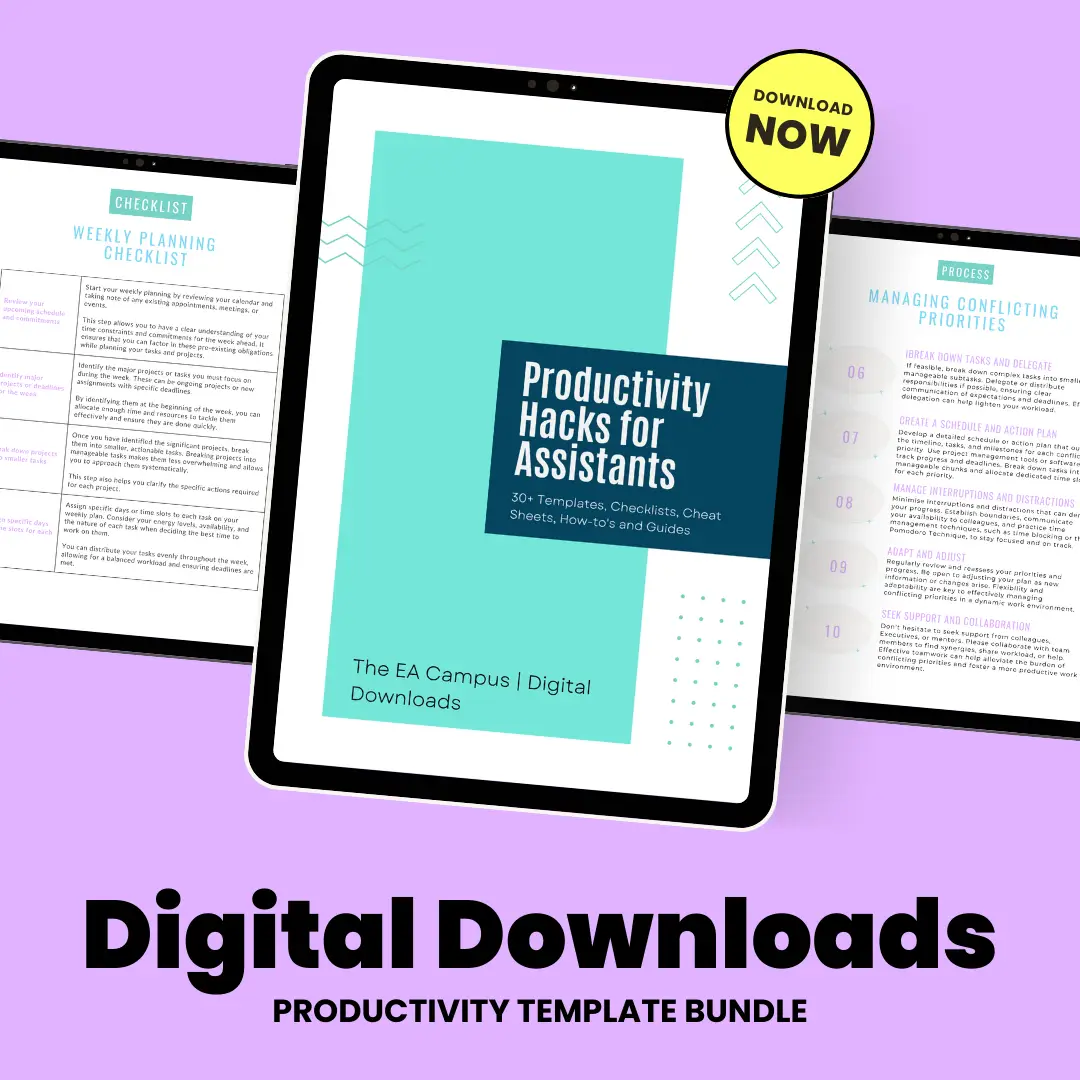Friday 21st February 2025
Designed specifically for Executive Assistants, Personal Assistants, and Administrative Professionals, this intensive three-hour live event will teach you to not just manage time but strategically align it to drive impactful results.
Led by Nicky Christmas, this session draws on years of industry experience, offering deep insights into how you can transform your approach to time management.

Learn how to prioritize tasks and allocate time in ways that directly contribute to your Executive’s and organization’s key objectives.
Understand how to conduct a detailed time audit to uncover inefficiencies in your daily tasks and Executive’s schedule.
Discover how to manage time during unforeseen circumstances, including high-stakes situations and emergencies.
In this section, you’ll learn how to go beyond day-to-day task management and strategically allocate time for maximum impact.
Maximizing Executive Impact with Time Allocation
You’ll discover techniques for aligning your Executive’s schedule with broader company goals, ensuring that every task contributes to high-impact business objectives. This segment will empower you to focus on activities that drive results and yield the highest return on time invested, transforming your approach to time management into a strategic asset.
Conducting a Time Audit for Efficiency
Effective time management starts with understanding how time is currently being used. In this part of the masterclass, you’ll learn how to conduct detailed time audits for both yourself and your Executive. You’ll be guided through step-by-step methods to evaluate workflows, uncover inefficiencies, and make data-driven changes to improve productivity. By regularly auditing time, you’ll continuously refine processes and ensure that both you and your Executive are making the best use of your time.
Navigating Time in High-Stress Situations
This section focuses on managing time during crises or high-stakes situations where flexibility is crucial. You’ll learn techniques to stay productive and calm under pressure while maintaining control over priority tasks. Whether dealing with an emergency or sudden change in priorities, this part will teach you how to adapt quickly without sacrificing strategic goals. The skills you develop here will help you thrive in unpredictable, high-pressure environments.
In Part two of the Strategic Time Management Masterclass, you will explore how to enhance your productivity by leveraging modern technology and mastering the art of delegation.
Time-Saving Technology for the Modern EA
Technology is a powerful tool for saving time, and this section will show you how to leverage it to your advantage. You’ll explore the latest time-management tools and automation technologies designed to streamline repetitive tasks. From AI-powered scheduling assistants to project management platforms, you’ll learn how to use these technologies to free up time for more strategic responsibilities. This part will provide actionable insights and practical demonstrations to boost your efficiency with cutting-edge tools.
Mastering Strategic Delegation
Time management isn’t just about personal efficiency; it’s also about how well you can delegate tasks within your team or department. In this segment, you’ll learn the art of strategic delegation—knowing when and how to delegate tasks effectively. You’ll discover techniques for managing follow-ups and ensuring quality results while fostering collaboration that saves time and enhances productivity. Strategic delegation helps you focus on high-priority tasks, while ensuring others are handled efficiently by your team.
Keeping the Schedule on Track
Managing an Executive’s calendar can be overwhelming, especially when there’s pressure to accommodate numerous priorities. In this section, you’ll learn how to keep your Executive’s schedule on track by managing time blocks strategically, avoiding overcommitment, and ensuring that critical tasks are prioritized. You’ll develop skills to balance long-term projects with daily responsibilities, ensuring that important objectives are consistently met without overwhelming your Executive’s calendar.
In part three, we shift the focus to long-term success and strategic time management. This section will equip you with the skills to incorporate forward-thinking into your daily routines, maintain momentum toward long-term goals, and ensure your communication is concise and impactful.
Time Management for Long-Term Success
Time management isn’t just about handling day-to-day tasks; it’s also about planning for the future. This section will teach you how to incorporate long-term planning into your daily routines, allowing you to focus on quarterly and annual goals. You’ll learn how to schedule time for strategic planning sessions, reviews, and key business objectives, ensuring that both you and your Executive stay on track with the broader vision. By mastering long-term time planning, you’ll contribute to the sustained success of your Executive and organization.
Maintaining Momentum and Managing Executive Time
Sustaining progress in the face of competing priorities is crucial to long-term success. In this segment, you’ll learn how to maintain momentum by balancing immediate demands with long-term goals. You’ll discover strategies to keep your Executive moving steadily toward business objectives without losing focus on daily tasks. This part emphasizes the importance of consistent progress and how to allocate your Executive’s time for both short-term wins and long-term achievements.
The Rule of Five for Concise Communication
Streamlining communication is key to saving time and ensuring clarity. In this section, you’ll learn the Rule of Five, a framework designed to help you communicate efficiently and concisely in any format—whether through emails, presentations, or meetings. By mastering this technique, you’ll be able to convey essential information quickly and clearly, minimizing misunderstandings and reducing the time spent on follow-ups. Effective communication plays a critical role in managing time and maintaining productivity.

You’ll learn how to align your daily tasks and your Executive’s schedule with broader business goals, ensuring that every minute spent contributes to high-impact results and drives organizational success.

Master the process of conducting time audits to identify inefficiencies in workflows and scheduling, enabling you to streamline operations and boost productivity for both yourself and your Executive.

Discover how to utilize modern time-management tools and automation technologies to handle repetitive tasks, freeing up your time for more strategic responsibilities and increasing overall efficiency.

Develop the skills to incorporate long-term planning into your routine, ensuring that both you and your Executive stay on track with quarterly, annual, and strategic business objectives.
We know that being an Assistant is not just about managing schedules or taking notes. It involves wearing multiple hats, problem-solving on the fly, and ensuring smooth operations amidst the chaos.
The digital materials provided in this bundle will equip you with the skills and strategies needed to maximise your potential and transform you into an exceptional Assistant.
Typically valued at $90, these templates are your secret weapon for effortlessly managing your time.

The Strategic Time Management Masterclass takes place on Friday 21st February 2025. The Masterclass starts at 10.00 am ET – 1.00 pm ET.
The Masterclass is 3 hours.
We would never want you to be unhappy! If you are unsatisfied with your purchase, contact us, and we will review your request.
Yes, get in touch with us. We will send you an invoice for the course. We also offer discounts for teams of Assistants.
When you sign up for the masterclass, you’ll also gain access to all the downloadable resources and recorded video training for three months. This way, you can revisit the course at your own pace and at your convenience.
Absolutely! We have many Assistants from all over the world who have completed the masterclass. The strategies you’ll learn in this Masterclass are universally applicable.